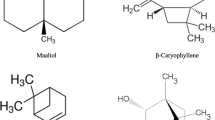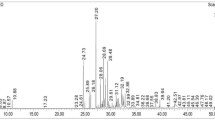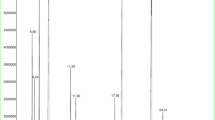Abstract
Mikania micrantha Kunth (mile-a-minute) is a major invasive weed with medicinal properties. It causes destruction of forests and threat to crop plantations, thus affecting the agriculture-based economy of a country. As an attempt to mitigate this problem, we have studied the applicability of M. micrantha flower essential oil against disease causing microorganisms and inhibition of cancerous cells. Sixty-six compounds were characterized from the flower essential oil by gas chromatography–mass spectrometry. The major constituents were: Isoledene (16%), δ-Cadinene (11.2%), Debromofiliformin (9.4%), Trans-Caryophyllene (9.1%), β-Bisabolene (7.4%), Germacrene-D (5.8%), and Zingiberene (5.3%). The oil is a complex mixture containing mainly sesquiterpene hydrocarbons (62.9%) and oxygenated sesquiterpenes (23.9%) with the other terpene compounds. Well-diffusion and resazurin assay were conducted to determine antimicrobial activity and minimum inhibitory concentration (MIC) of the essential oil. Flower oil showed best activity against Mycobacterium smegmatis and Candida albicans with MIC 8 µg/mL. Moreover, it is the first report of antimicrobial activity of the oil towards M. smegmatis, C. albicans, Staphylococcus aureus, and Pseudomonas aeruginosa. Minimum bactericidal and fungicidal concentration was determined and mechanism of antimicrobial activity was investigated by Field Emission-Scanning Electron Microscopy and Transmission Electron Microscopy analysis. It is the first cytotoxicity report of M. micrantha flower essential oil for cervical, ovarian, and pancreatic cancer cell lines. Through MTT (3-(4,5-dimethylthiazol-2-yl)-2,5-diphenyltetrazolium bromide) assay, we have found that oil has excellent cytotoxicity against HeLa cervical cancer cell lines (IC50 5.44 ± 1.33 µg/mL) and PA1 ovarian cancer cell lines (IC5010.57 ± 1.44 µg/mL). The essential oil extracted from the invasive weed M. micrantha flower is now found to have antimicrobial and anticancer properties from our study. Thus, this harmful weed can be utilized as antimicrobial and anticancer agents for the healthcare of human being.





Similar content being viewed by others
References
Adams RP (2007) Identification of essential oil components by gas chromatography/mass spectrometry, 4th edn. Allured Publishing Corporation, Carol Stream
Afoulous S, Ferhout H, Raoelison EG, Valentin A, Moukarzel B, Couderc F, Bouajila J (2013) Chemical composition and anticancer, antiinflammatory, antioxidant and antimalarial activities of leaves essential oil of Cedrelopsis grevei. Food Chem Toxicol 56:352–362. https://doi.org/10.1016/j.fct.2013.02.008
Andriamaharavo NR (2014) Retention Data, (NIST Mass Spectrometry Data Center) NIST Mass Spectrometry Data Center
Asif M, Shafaei A, Jafari SF, Mohamed SK, Ezzat MO, Abdul Majid AS, Oon CE, Petersen SH, Kono K, Abdul Majid AM (2016) Isoledene from Mesua ferrea oleo-gum resin induces apoptosis in HCT 116 cells through ROS-mediated modulation of multiple proteins in the apoptotic pathways: a mechanistic study. Toxicol Lett 257:84–96. https://doi.org/10.1016/j.toxlet.2016.05.027
Ayensu ES (1981) Medicinal plants of the West Indies. Reference Publications Inc, USA
Bordoloi M, Saikia S, Kolita B, Sarmah R, Roy S, Narzary B (2018) Volatile inhibitors of phosphatidylinositol-3-kinase (PI3K) pathway: anticancer potential of aroma compounds of plant essential oils. Anti-Cancer Agents Med Chem 1:87–109. https://doi.org/10.2174/1871520617666170327105706
Bouyahya A, Dakka N, Talbaoui A, Et-Touys A, El-Boury H, Abrini J, Bakri Y (2017) Correlation between phenological changes, chemical composition and biological activities of the essential oil from Moroccan endemic Oregano (Origanum compactum Benth). Ind Crop Prod 108:729–737. https://doi.org/10.1016/j.indcrop.2017.07.033
Brehm-Stecher BF, Johnson EA (2003) Sensitization of Staphylococcus aureus and Escherichia coli to antibiotics by the sesquiterpenoids nerolidol, farnesol, bisabolol, and apritone. Antimicrob Agents Chemother 47:3357–3360. https://doi.org/10.1128/aac.47.10.3357-3360.2003
Brigida da Silva AS, Owiti AO, Barbosa WL (2018) Pharmacology of Mikania genus: a systematic review. Pharmacogn Rev 12:230–237. https://doi.org/10.4103/phrev.phrev_10_18
Burt S (2004) Essential oils: their antibacterial properties and potential applications in foods-a review. Int J Food Microbiol 94:223–253. https://doi.org/10.1016/j.ijfoodmicro.2004.03.022
Calixto JB (2000) Efficacy, safety, quality control, marketing and regulatory guidelines for herbal medicines (phytotherapeutic agents). Braz J Med Biol Res 33(2):179–189. https://doi.org/10.1590/s0100-879x2000000200004
CLSI (2012) Methods for dilution antimicrobial susceptibility test for bacteria that grow aerobically, approved standard, 9th edn. vol 32, no 2. ISBN: 1-56238988-2
De Santi II, Gatto DA, Machado MRG, Dos Santos PSB, Freitag RA (2017) Chemical composition, antioxidant and antimicrobial activity of the oil and plant extract Myrocarpus frondosus Allemao. Am J Plant Sci 8:1560–1571. https://doi.org/10.4236/ajps.2017.87108
Dutta PP, Bordoloi M, Gogoi K, Roy S, Narzary B, Bhattacharyya DR, Mohapatra PK, Mazumder B (2017) Antimalarial silver and gold nanoparticles: green synthesis, characterization and in vitro study. Biomed Pharmacother 91:567–580. https://doi.org/10.1016/j.biopha.2017.04.032
Facey PC, Pascoe KO, Porter RB, Jones AD (1999) Investigation of plants used in Jamaican folk medicine for anti-bacterial activity. J Pharm Pharmacol 51:1455–1460. https://doi.org/10.1211/0022357991777119
Juliani HR, Licayan RI, Del Rosario RM, Palmes ND, Simon JE (2016) Physical and chemical properties, composition, and biological activity of essential oils of Philippine medicinal plants. J Med Act Plants 5:28–35. https://doi.org/10.7275/R5P84933
Jung WK, Koo HC, Kim KW, Shin S, Kim SH, Park YH (2008) Antibacterial activity and mechanism of action of the silver ion in Staphylococcus aureus and Escherichia coli. Appl Environ Microbiol 74(7):2171–2178. https://doi.org/10.1128/AEM.02001-07
Jyothilakshmi M, Jyothisand M, Latha MS (2015) Antidermatophytic activity of Mikania micrantha Kunth: an invasive weed. Pharmacogn Res 7:S20–S25. https://doi.org/10.4103/0974-8490.157994
Martin A, Palomino JC (2012) Procedure manual, colorimetric redox indicator (CRI), drug susceptibility testing for Mycobacterium tuberculosis, version 06
Matawali A, Lee PC, How SE, Jualang AG (2016) Antibacterial and Phytochemical Investigations of Mikania micrantha H.B.K. (Asteraceae) From Sabah, Malaysia. Trans Sci Technol 3:244–250
Mulyaningsih S, Sporer F, Zimmermann S, Reichling J, Wink M (2010) Synergistic properties of the terpenoids aromadendrene and 1, 8-cineole from the essential oil of Eucalyptus globules against antibiotic-susceptible and antibiotic-resistant pathogens. Phytomedicine 17:1061–1066. https://doi.org/10.1016/j.phymed.2010.06.018
Nayak SK, Maharana M, Jagat S, Khatoon A, Satapathy KB (2017) Anti-bacterial potential and qualitative phytochemical analysis of an invasive alien plant Mikania micrantha kunth found in Dhenkanal district of Odisha, India. Int J Pharm Sci Rev Res 42:32–35
Nazzaro F, Fratianni F, De Martino L, Coppola R, De Feo V (2013) Effect of essential oils on pathogenic bacteria. Pharmaceuticals 6:1451–1474. https://doi.org/10.3390/ph6121451
NCCLS (1999) National Committee for Clinical Laboratory Standards, Methods for Determining Bactericidal Activity of Antimicrobial Agents; Approved Guideline, M-26A, vol 19, no 18. ISBN: 1-56238-384-1
Nicollier G, Thompson AC (1981) Essential oil and terpenoids of Mikania micrantha. Phytochemistry 20:2587–2588. https://doi.org/10.1016/0031-9422(81)83102-0
Oussalah M, Caillet S, Saucier L, Lacroix M (2007) Inhibitory effects of selected plant essential oils on the growth of four pathogenic bacteria: E. coli O157:H7, Salmonella typhimurium, Staphylococcus aureus and Listeria monocytogenes. Food Control 18:414–420. https://doi.org/10.1016/j.foodcont.2005.11.009
Padalia RC, Verma RS, Chauhan A, Singh VR, Goswami P, Singh S, Verma SK, Luqman S, Chanotiya CS, Darokar MP (2018) Zingiber zerumbet (L.) Roscoe ex Sm. from northern India: potential source of zerumbone rich essential oil for antiproliferative and antibacterial applications. Ind Crop Prod 112:749–754. https://doi.org/10.1016/j.indcrop.2018.01.006
Perez-Amador MC, Ocotero VM, Balcazar RI, Jimenez FG (2010) Phytochemical and pharmacological studies on Mikania micrantha H.B.K. (Asteraceae). PHYTON-Int J Exp Bot 79:77–80
Rahman HS (2016) Natural products for cancer therapy. Dual Diagn 1(2):15. https://doi.org/10.21767/2472-5048.100015
Rostad CE, Pereira WE (1986) Kovats and Lee retention indices determined by gas chromatography/mass spectrometry for organic compounds of environmental interest. J High Res Chromatogr 9:328–334. https://doi.org/10.1002/jhrc.1240090603
Rufatto LC, Gower A, Schwambach J, Moura S (2012) Genus Mikania: chemical composition and phytotherapeutical activity. Braz J Pharmacogn 22(6):1384–1403. https://doi.org/10.1590/S0102-695X2012005000099
Sarker SD, Nahar L, Kumarasamy Y (2007) Microtitre plate-based antibacterial assay incorporating resazurin as an indicator of cell growth, and its application in the in vitro antibacterial screening of phytochemicals. Methods 42:321–324. https://doi.org/10.1016/j.ymeth.2007.01.006
Shao H, Nan P, Peng S, Zhang C (2001) Study of chemical constituents of essential oil from flowers of Mikania micrantha H.B.K. Zhong Yao Cai (J Chin Med Mater) 24:341–342
Shen S, Xu G, Zhang F, In GJ, Liu S, Liu M, Chen A, Zhang Y (2013) Harmful effects and chemical control study of Mikania micrantha H.B.K. in Yunnan, Southwest China. Afr J Agric Res 8(44):5554–5561. https://doi.org/10.5897/ajar2013.7688
Swamy MK, Akhtar MS, Sinniah UR (2016) Antimicrobial properties of plant essential oils against human pathogens and their mode of action: an updated review. Evid Based Complement Altern Med 2016:3012462. https://doi.org/10.1155/2016/3012462
Talukdar M, Bordoloi M, Dutta PP, Saikia S, Kolita B, Talukdar S, Nath S, Saikia R, Jha DK, Bora TC, Yadav A (2016) Structure elucidation and biological activity of antibacterial compound from Micromonospora auratinigra, a soil actinomycetes. J Appl Microbiol 121:973–987. https://doi.org/10.1111/jam.13233
Vagionas K, Graikou K, Chinou IB, Runyoro D, Ngassapa O (2007) Chemical analysis and antimicrobial activity of essential oils from the aromatic plants Artemisia afra Jacq. and Leonotis ocymifolia (Burm.F.) Iwarsson var. Raineriana (vision1) Iwarsson growing in Tanzania. J Essent Oil Res 19:396–400. https://doi.org/10.1080/10412905.2007.9699314
Valcourt C, Saulnier P, Umerska A, Zanelli MP, Montagu A, Rossines E, Joly-Guillou ML (2016) Synergistic interactions between doxycycline and terpenic components of essential oils encapsulated within lipid nanocapsules against gram negative bacteria. Int J Pharm 498:23–31. https://doi.org/10.1016/j.ijpharm.2015.11.042
Wiegand I, Hilpert K, Hancock REW (2008) Agar and broth dilution methods to determine the minimal inhibitory concentration (MIC) of antimicrobial substances. Nat Protocol 3(2):163–175. https://doi.org/10.1038/nprot.2007.521
Acknowledgements
We thank the Director, CSIR-North East Institute of Science and Technology, Jorhat, Assam for providing facilities and CSIR, DBT [GPP-346, Sl No. 102/IFD/SAN/2241/2018/2019] New Delhi for the grant of projects [CSC-0130 & 0207 & OLP-2020]. BN acknowledges MoTA, New Delhi for fellowship grant 201718-NFST-ASS-00448.
Author information
Authors and Affiliations
Corresponding author
Ethics declarations
Conflict of interest
The authors have no conflict of interests to declare.
Additional information
Publisher's Note
Springer Nature remains neutral with regard to jurisdictional claims in published maps and institutional affiliations.
Rights and permissions
About this article
Cite this article
Saikia, S., Tamuli, K.J., Narzary, B. et al. Chemical characterization, antimicrobial activity, and cytotoxic activity of Mikania micrantha Kunth flower essential oil from North East India. Chem. Pap. 74, 2515–2528 (2020). https://doi.org/10.1007/s11696-020-01077-6
Received:
Accepted:
Published:
Issue Date:
DOI: https://doi.org/10.1007/s11696-020-01077-6




